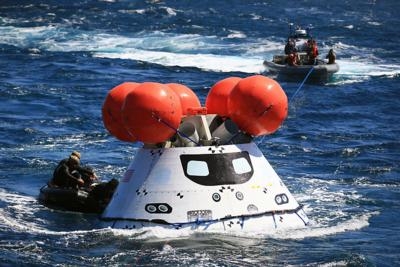Teams Continue To Prepare For December Flight
NASA, Orion prime contractor Lockheed Martin and the U.S. Navy successfully completed the third round of tests to practice recovering Orion when it splashes down off the coast of San Diego at the end of its December flight test. The mid-September test series, led by NASA's Ground Systems Development and Operations (GSDO) Program, continued to perfect techniques and ensure the full team and all equipment are ready when Orion returns to Earth after traveling more than 3,600 miles in altitude away from the planet.

Two Navy ships, a test version of Orion, several support boats, two helicopters and associated hardware and equipment were used for the tests.
The teams practiced two methods for recovering Orion. The first test began Sept. 11 at Naval Base San Diego, with loading of the test vehicle, equipment and hardware aboard the USNS Salvor (T-ARS 52), a safeguard-class rescue and salvage ship. Also on board were Navy radiomen and a civilian crew. The ship headed out to sea Sept. 12 to test a backup recovery method using the ship's stationary crane.
"The test was a success thanks to the expertise of the Salvor crew, Navy divers and the Department of Defense," said Marcos Pena, GSDO Technical Integration lead for crane recovery. "Recovery of the Orion crew module is essential to the success of Orion's flight test and subsequent Orion and Space Launch System missions in the years to come."
Starting in calm seas, the team used a 40-ton aft boom crane attached to the Navy ship to retrieve the 20,000 pound Orion test vehicle from the water. They continued recovery efforts in more challenging waters to determine recommended weather and sea condition limits for crane recovery.
During this test, Navy divers practiced attaching a “horse collar” around Orion and four tending lines that helped control lateral and longitudinal motion during crane recovery. The team also evaluated a basket lift rigging, consisting of 10 slings that were placed around Orion during crane lift operations.
"The basket lift rigging was tested previously on the USS Anchorage," said Pena. "We were able to take the next step and demonstrate that the basket lift rig and horse collar can be used to lift the test vehicle over the side of the ship and set it on a cradle on the ship's deck, all while maintaining motion control."
Tether lines from the ship were attached to Orion for towing tests at various speeds and can be used to bring the capsule to calmer waters for recovery.
On Sept. 15, the USNS Salvor rendezvoused with the USS Anchorage in the open sea and handed off the Orion test vehicle for the next portion of the recovery test.
During the week, the team performed an end-to-end recovery simulation using the ship's well deck, two of the Navy's Zodiac boats, four rigid hull inflatable boats, two helicopters and equipment and procedures that were used during August testing.
U.S. Navy divers in Zodiac boats and other team members in rigid hull inflatable boats were stationed in the water near the test vehicle. Orange stabilizers on the top of the test vehicle were inflated to simulate the system that will be used to upright Orion in the water after splashdown.
Using tether lines attached to the test vehicle, the team guided Orion back to the ship. In the well deck, NASA and Lockheed Martin workers set up a capture net, crew module recovery cradle, wing well fenders, speed bumps, and used a recovery winch, horse collar and Kevlar tending lines to stabilize Orion in the well deck.
During the week, they also practiced retrieving a mock-up of Orion's forward bay cover, a shell that fits over Orion’s crew module to protect the spacecraft during launch, orbital flight and reentry.
“Successful completion of this test series marks a significant milestone in NASA's partnership with the Navy to recover the Orion crew module after it splashes down in the Pacific Ocean in December,” said Jeremy Graeber, GSDO NASA Recovery director. "The integrated team has done an amazing job working to refine the procedures to make this mission a success. I feel confident that our team and hardware are ready to support Exploration Flight Test-1.”
Other goals of the test were to assess on-ship communications and ship-to-shore communications, as well as recording timing data for recovery activities to help provide future recovery methods for crewed missions.
The USS Anchorage returned to Naval Base San Diego on Sept. 19. The Orion test vehicle and recovery equipment were offloaded from the ship.
(Images provided by NASA)
 Airborne 06.30.25: US v ADS-B Misuse, Natl STOL Fire, Volocopter Resumes
Airborne 06.30.25: US v ADS-B Misuse, Natl STOL Fire, Volocopter Resumes NTSB Prelim: Piper PA-23
NTSB Prelim: Piper PA-23 ANN FAQ: Submit a News Story!
ANN FAQ: Submit a News Story! Classic Aero-TV: One Mans Vietnam
Classic Aero-TV: One Mans Vietnam Klyde Morris (06.30.25)
Klyde Morris (06.30.25)



